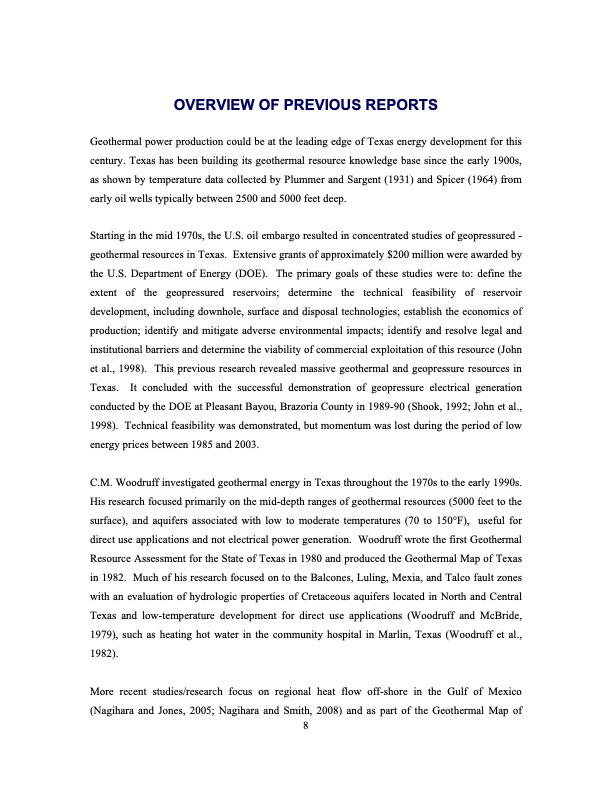
PDF Publication Title:
Text from PDF Page: 009
OVERVIEW OF PREVIOUS REPORTS Geothermal power production could be at the leading edge of Texas energy development for this century. Texas has been building its geothermal resource knowledge base since the early 1900s, as shown by temperature data collected by Plummer and Sargent (1931) and Spicer (1964) from early oil wells typically between 2500 and 5000 feet deep. Starting in the mid 1970s, the U.S. oil embargo resulted in concentrated studies of geopressured - geothermal resources in Texas. Extensive grants of approximately $200 million were awarded by the U.S. Department of Energy (DOE). The primary goals of these studies were to: define the extent of the geopressured reservoirs; determine the technical feasibility of reservoir development, including downhole, surface and disposal technologies; establish the economics of production; identify and mitigate adverse environmental impacts; identify and resolve legal and institutional barriers and determine the viability of commercial exploitation of this resource (John et al., 1998). This previous research revealed massive geothermal and geopressure resources in Texas. It concluded with the successful demonstration of geopressure electrical generation conducted by the DOE at Pleasant Bayou, Brazoria County in 1989-90 (Shook, 1992; John et al., 1998). Technical feasibility was demonstrated, but momentum was lost during the period of low energy prices between 1985 and 2003. C.M. Woodruff investigated geothermal energy in Texas throughout the 1970s to the early 1990s. His research focused primarily on the mid-depth ranges of geothermal resources (5000 feet to the surface), and aquifers associated with low to moderate temperatures (70 to 150°F), useful for direct use applications and not electrical power generation. Woodruff wrote the first Geothermal Resource Assessment for the State of Texas in 1980 and produced the Geothermal Map of Texas in 1982. Much of his research focused on to the Balcones, Luling, Mexia, and Talco fault zones with an evaluation of hydrologic properties of Cretaceous aquifers located in North and Central Texas and low-temperature development for direct use applications (Woodruff and McBride, 1979), such as heating hot water in the community hospital in Marlin, Texas (Woodruff et al., 1982). More recent studies/research focus on regional heat flow off-shore in the Gulf of Mexico (Nagihara and Jones, 2005; Nagihara and Smith, 2008) and as part of the Geothermal Map of 8PDF Image | Texas Geothermal Assessment for the I35 Corridor East

PDF Search Title:
Texas Geothermal Assessment for the I35 Corridor EastOriginal File Name Searched:
TexasGeothermalAssessment_I_35Corridor.pdfDIY PDF Search: Google It | Yahoo | Bing
NFT (Non Fungible Token): Buy our tech, design, development or system NFT and become part of our tech NFT network... More Info
IT XR Project Redstone NFT Available for Sale: NFT for high tech turbine design with one part 3D printed counter-rotating energy turbine. Be part of the future with this NFT. Can be bought and sold but only one design NFT exists. Royalties go to the developer (Infinity) to keep enhancing design and applications... More Info
Infinity Turbine IT XR Project Redstone Design: NFT for sale... NFT for high tech turbine design with one part 3D printed counter-rotating energy turbine. Includes all rights to this turbine design, including license for Fluid Handling Block I and II for the turbine assembly and housing. The NFT includes the blueprints (cad/cam), revenue streams, and all future development of the IT XR Project Redstone... More Info
Infinity Turbine ROT Radial Outflow Turbine 24 Design and Worldwide Rights: NFT for sale... NFT for the ROT 24 energy turbine. Be part of the future with this NFT. This design can be bought and sold but only one design NFT exists. You may manufacture the unit, or get the revenues from its sale from Infinity Turbine. Royalties go to the developer (Infinity) to keep enhancing design and applications... More Info
Infinity Supercritical CO2 10 Liter Extractor Design and Worldwide Rights: The Infinity Supercritical 10L CO2 extractor is for botanical oil extraction, which is rich in terpenes and can produce shelf ready full spectrum oil. With over 5 years of development, this industry leader mature extractor machine has been sold since 2015 and is part of many profitable businesses. The process can also be used for electrowinning, e-waste recycling, and lithium battery recycling, gold mining electronic wastes, precious metals. CO2 can also be used in a reverse fuel cell with nafion to make a gas-to-liquids fuel, such as methanol, ethanol and butanol or ethylene. Supercritical CO2 has also been used for treating nafion to make it more effective catalyst. This NFT is for the purchase of worldwide rights which includes the design. More Info
NFT (Non Fungible Token): Buy our tech, design, development or system NFT and become part of our tech NFT network... More Info
Infinity Turbine Products: Special for this month, any plans are $10,000 for complete Cad/Cam blueprints. License is for one build. Try before you buy a production license. May pay by Bitcoin or other Crypto. Products Page... More Info
| CONTACT TEL: 608-238-6001 Email: greg@infinityturbine.com | RSS | AMP |